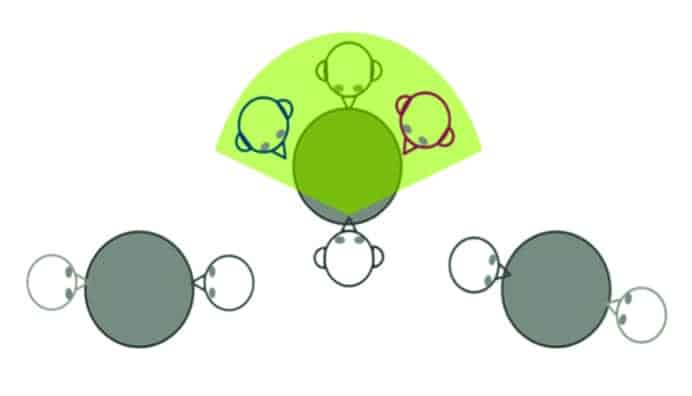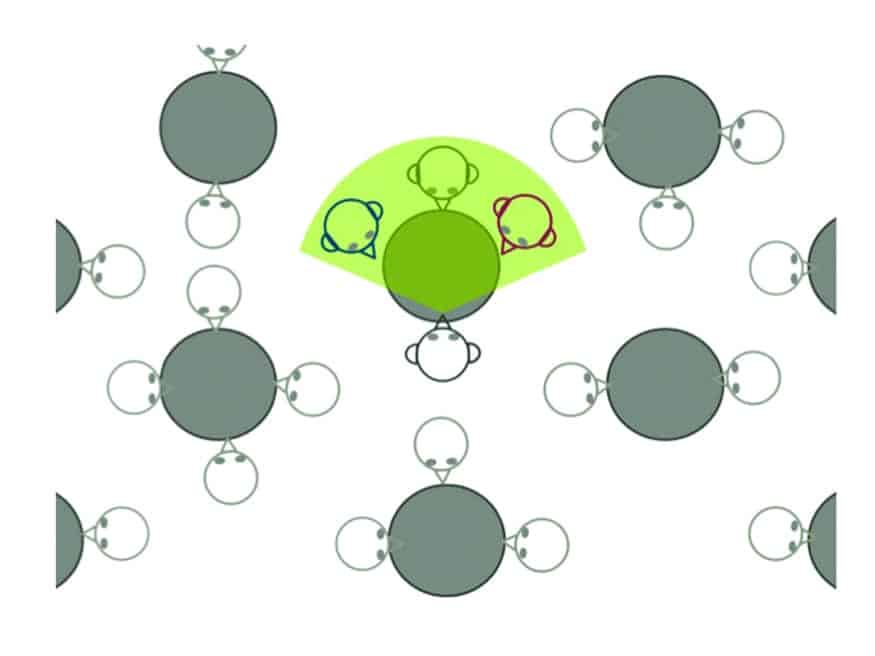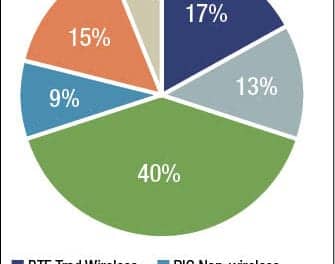Tech Topic | November 2014 Hearing Review
By Jennifer Appleton, MSc, and Gabriel König
The objective of this study was to investigate the effects of the new adaptive behavior of the Phonak binaural beamformer (StereoZoom) in comparison to both its static behavior and the adaptive monaural beamformer (UltraZoom). The findings indicate that the new adaptive behavior of StereoZoom provides significant benefit, in terms of both speech intelligibility and subjective rating when compared to static or monaural beamformers. This benefit is most evident in difficult listening environments such as when noise is predominantly present from the sides.
Directional microphones improve understanding in difficult listening situations, particularly situations where there is a lot of background noise.1-4 In general, they focus on speech coming from the front while attenuating noise from behind.

[Click on images to enlarge.] Figure 1. An example of a listening situation where UltraZoom has been shown to be of significant benefit. A hearing aid user is listening to the people within the green shaded area. Noise comes from two prominent sound sources (the people sitting at the gray tables).

Figure 2. An example of a listening situation where StereoZoom has shown to be of significant benefit. The hearing aid user is listening to people within the green shaded area. He is surrounded by noise sources from several different directions, which creates a diffuse noise environment.
On the other hand, the binaural beamformer, StereoZoom, has been shown to provide directional benefit in situations where the noise environment is diffuse.7-10 A typical example of this situation can be seen in Figure 2, which shows a hearing aid wearer (head in the center of the picture) having a conversation with three other people within the green shaded area. Noise is coming from many directions, which creates a diffuse noise environment.
StereoZoom works by creating a bidirectional network of four microphones, which produces a strongly focused directional effect. This enhanced directional characteristic, which provides a considerably improved attenuation of noise energy, produces a very narrow focus of ±45° and the potential for an improved signal-to-noise ratio (SNR).
A new adaptive behavior of StereoZoom has been developed that aims to incorporate the benefits of both a binaural system and an adaptive system. The following study is designed to investigate the performance of the adaptive behavior of StereoZoom and to compare it to both UltraZoom and the static behavior of StereoZoom.
Study Design
A total of 20 subjects with hearing losses ranging from mild-moderate to moderate-severe were included in the study. They were fitted with Phonak behind-the-ear (BTE) or receiver-in-the-canal (RIC) hearing aids according to their hearing loss. Appropriate hearing aid coupling was chosen, including open fittings where indicated. Hearing aids were programmed according to the first fit and coupling data. Programs were set up with the following beamformer settings:
- Program 1 (P1): Omnidirectional microphone mode;
- Program 2 (P2): Monaural adaptive beamformer (UltraZoom);
- Program 3 (P3): Binaural static beamformer (static StereoZoom); and
- Program 4 (P4): Binaural adaptive beamformer (adaptive StereoZoom).

Figure 3a-b. In Version 1 (left) of the OLSA test set-up, a diffuse noise environment is created by all 11 speakers presenting cafeteria babble noise. In Version 2 (right) of the set-up, noise from the sides is created by presenting cafeteria babble noise from only the speakers at 90º and 270° azimuth.
Speech intelligibility of the various beamformers was assessed using the Oldenburger Satztest (OLSA). The test was carried out using two different versions of the test set-up. Figure 3a-b shows these two different versions. In both versions, the subject was seated at the center of a circle of 12 loudspeakers, facing the speaker at 0° azimuth. The OLSA speech material was presented from this speaker. In Version 1 of the set-up, cafeteria babble noise was presented from all other 11 loudspeakers, which created a diffuse noise environment. In Version 2 of the set-up, cafeteria babble noise was presented from loudspeakers at angles 90° and 270° only, creating a situation where only noise from the sides was present. Speech reception thresholds (SRT) were obtained for all subjects using all four programs in both test set-up versions.
Subjective assessment was carried out using the same set-up as for the OLSA in Figure 3. However, the speech material presented was a male voice signal taken from the Phonak CD (iPFG Sound CD2). The cafeteria babble noise was present either as diffuse noise or from two prominent directions. A fixed negative SNR was used to represent a demanding listening situation. This time, subjects were required to rate the three programs with directional microphone technologies in terms of speech intelligibility, suppression of interferers, and overall quality. The rating was on a scale of 0-100 (0 being very poor, 100 being very good). Subjects could select the programs (blinded) via a touchscreen, which was connected to a software that steered the hearing aid programs. Thus the subjects could compare and rate the programs simultaneously in the respective scene.
Results
The directional benefit of the different beamformers was calculated using the following formula: SRTomni – SRTBF. In other words, the SRT obtained by using either P2, P3, or P4 was subtracted from the SRT obtained when using P1 (omnidirectional microphone mode only).

Figure 4. SRT benefit of the beamformers UltraZoom (grey), static StereoZoom (light green), and adaptive StereoZoom (dark green) within a diffuse noise environment (Version 1).
This directional benefit can be seen in Figure 4 for set-up Version 1 (diffuse noise environment) and in Figure 5 for set-up Version 2 (noise from the sides environment).

Figure 5. SRT benefit of the beamformers UltraZoom (grey), static StereoZoom (light green), and adaptive StereoZoom (dark green) when noise was presented from the sides only (Version 2).
Anova analysis indicated that significant differences (p < 0.01) were present between the beamformers for both set-up versions. The results indicate that, for diffuse noise situations, both static and adaptive StereoZoom provides more speech reception threshold benefit than UltraZoom. For situations where noise is coming from the sides only, adaptive StereoZoom provides more speech reception threshold benefit than static StereoZoom.

Figure 6. Results of subjective rating of UltraZoom (grey), static StereoZoom (light green), and adaptive StereoZoom (dark green) within the diffuse noise environment (Version 1). Rating was on a scale of 0-100 (with 0 being very poor and 100 being very good).
Results of the subjective assessment are shown in Figures 6 and 7. The subjective results are in some respect consistent with the results of the objective OLSA test. For example, for the diffuse noise environment, speech intelligibility and suppression of interferers were rated better for both static and adaptive StereoZoom than for UltraZoom.

Figure 7. Results of subjective rating of UltraZoom (grey), static StereoZoom (light green), and adaptive StereoZoom (dark green) within the environment where noise is only present from the sides (Version 2). Rating was on a scale of 0-100 (0 being very poor and 100 being very good).
Also consistent with OLSA results, in Version 2 (noise from the sides), adaptive StereoZoom was rated better than static StereoZoom in all three categories. Anova analysis revealed that these observations were of significant difference (p < 0.01).
Conclusion
Both speech intelligibility results and subjective assessment indicate that the new adaptive behavior of StereoZoom provides benefit over the monaural beamformer (UltraZoom) in diffuse noise environments. Furthermore, the new adaptive behavior of StereoZoom additionally provides both objective and subjective benefit over the static binaural beamformer (static StereoZoom) in environments with prominent noise from the sides.
Subjective findings show an additional form of benefit as the evaluation was done in a realistic scenario and the subjects indicated their perceived impression for the various settings. Results indicate that the adaptive behavior of StereoZoom combines the benefit of binaural beamforming, such as in the static form of StereoZoom, with the adaptive steering of the beamformer, such as in UltraZoom.
Generally speaking, the adaptive behavior of StereoZoom has the capability to achieve best performance in both highly diffuse noise scenes and scenes with prominent noise from the rear or even the sides. The performance of this beamformer should help wearers of Phonak hearing aids hear even better in difficult listening situations, particularly when noise is present from the sides only.
References
1. Ricketts TA. Directional hearing aid benefit in listeners with severe hearing loss. Int J Audiol. 2006;45:190-197.
2. Wouters J, Litierère L, van Wieringen A. Speech intelligibility in noisy environments with one- and two-microphone hearing aids. Audiology. 1999;38:91-98.
3. Chung K. Challenges and recent developments in hearing aids. Part I. Speech understanding in noise, microphone technologies and noise reduction algorithms. Trends Amplif. 2004;8(3):83-124.
4. Hamacher V, Eggers J, Fischer E, Kornagel U, Puder H, Rass U. Signal processing in high-end Hearing aids: state of the art, challenges, and future trends EURASIP. J Applied Signal Processing. 2005;18:2915–2929.
5. Wouters J, Vanden Berghe J, Maj J-B. Adaptive noise suppression for a dual-microphone hearing aid. Int J Audiol. 2002;41:401-407.
6. Ricketts TA, Henry P. Evaluation of an adaptive, directional-microphone hearing aid. Int J Audiol. 2002;41:100-112.
7. Picou EM, Aspell E, Ricketts TA. Potential benefits and limitations of directional processing in hearing aids. Ear Hear. 2014;35(3):339-352.
8. Latzel M. Concepts for binaural processing in hearing aids. Hearing Review. 2013;20(4):34.
9. Nyffeler M. StereoZoom—Improvements with directional microphones. Field Study News. Erlangen, Germany: Phonak AG: 2010.
10. Stuermann B. StereoZoom—Improved speech understanding even with open fittings. Field Study News. Erlangen, Germany: Phonak AG: 2011.
CORRESPONDENCE can be addressed to Jennifer Appleton at: [email protected]
Original citation for this article: Appleton J, König G. Improvement in speech intelligibility and subjective benefit with binaural beamformer technology. Hearing Review. 2014;21(11)[Nov]:40-42.





